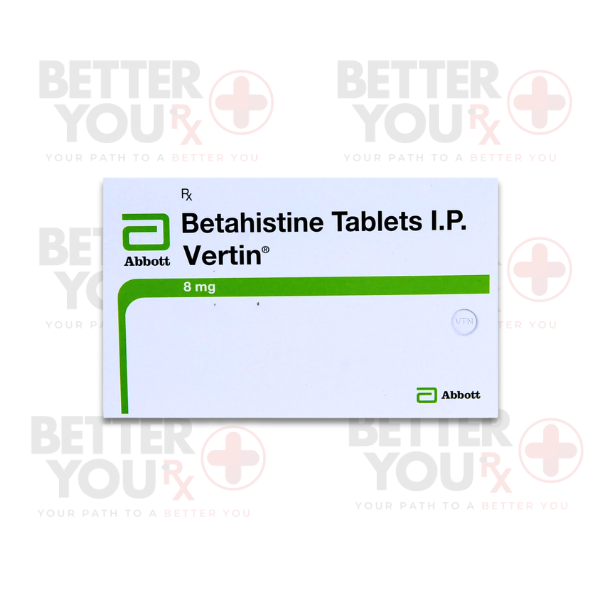Description
Vertin, with its active ingredient betahistine, is a medication primarily used to treat balance disorders and vertigo. It is especially effective for patients suffering from Meniere’s disease, benign paroxysmal positional vertigo (BPPV), and other vestibular conditions. Vertigo, which is often characterized by dizziness, nausea, and a sensation of spinning, can significantly impact a person’s quality of life. Vertin works by improving blood flow to the inner ear, which helps to normalize the pressure and alleviate symptoms such as dizziness and hearing disturbances.
Vertin has a long track record of being a reliable treatment for various types of dizziness associated with inner ear dysfunction. Its mechanism of action focuses on restoring fluid balance and reducing pressure within the inner ear, which is crucial for maintaining proper balance. By addressing the underlying causes of vertigo, Vertin helps restore patients’ mobility, reduces the frequency of vertigo attacks, and contributes to their overall well-being.
Uses of Vertin
Vertin is primarily used to treat:
- Meniere’s disease: This inner ear disorder causes recurring episodes of vertigo, tinnitus, and hearing loss. Vertin helps manage these symptoms and reduce the frequency of attacks.
- Benign paroxysmal positional vertigo (BPPV): A condition that causes brief, intense dizziness triggered by certain head movements. Vertin helps relieve these dizziness episodes by improving blood circulation in the ear.
- Vestibular vertigo: General dizziness caused by disturbances in the inner ear’s balance system. Vertin can be used to manage dizziness caused by various conditions affecting the vestibular system.
How Vertin Works
The active ingredient, betahistine, works by enhancing blood flow to the inner ear, which improves its function and reduces pressure. This helps alleviate the symptoms of vertigo by correcting the imbalance in the ear. Betahistine also acts on histamine receptors in the brain, which helps regulate blood flow and reduce the intensity of dizziness. By improving circulation and stabilizing fluid levels in the inner ear, Vertin effectively reduces the frequency and severity of vertigo episodes.
Benefits of Vertin
- Effective for vertigo and balance disorders: Vertin is one of the most effective treatments for vertigo, particularly for conditions like Meniere’s disease and BPPV.
- Improves daily functioning: By reducing the severity of dizziness, Vertin helps improve a patient’s quality of life, allowing them to engage in everyday activities without the fear of sudden vertigo attacks.
- Quick symptom relief: Many users report feeling improvement in their symptoms within a few days to weeks of starting treatment.
- Non-sedating: Unlike many other medications used to treat vertigo, Vertin does not cause sedation or excessive drowsiness, which allows users to stay active throughout the day.
How to Use Vertin
- Dosage: The typical dosage of Vertin ranges from 8 mg to 16 mg, taken two to three times per day.
- For Meniere’s disease: Patients may be prescribed a higher dose, typically 24 mg to 48 mg per day, depending on the severity of their symptoms.
- Administration: Vertin should be taken with food to minimize gastrointestinal discomfort. It is essential to follow your doctor’s instructions on the appropriate dosage based on your condition.
- Consistency is key: For the best results, it is crucial to take Vertin regularly as prescribed by your doctor.
Potential Side Effects of Vertin
Vertin is generally well tolerated, but like any medication, it can cause side effects in some individuals. Common side effects include:
- Nausea
- Headache
- Indigestion or abdominal discomfort
- Dizziness (paradoxical)
- Fatigue
In rare cases, more serious side effects may occur, such as:
- Skin rash
- Swelling of the face or throat
- Breathing difficulties
- Liver function abnormalities
- Irregular heartbeat or palpitations
If any of these severe reactions occur, seek medical attention immediately.
Precautions and Warnings
- Pregnancy and breastfeeding: Vertin should be used during pregnancy only if the benefits outweigh the risks, and it is not recommended during breastfeeding without consulting a doctor.
- Liver or kidney issues: People with liver or kidney disorders should use Vertin with caution, as adjustments to the dosage may be necessary.
- Drug interactions: Vertin may interact with other medications, especially antihistamines, monoamine oxidase inhibitors (MAOIs), and certain antidepressants. Inform your doctor of any other drugs you are taking.
- Allergic reactions: If you have a history of allergic reactions to betahistine or other components of Vertin, inform your doctor before use.
Storage Instructions
- Store Vertin in a cool, dry place, away from moisture and direct light.
- Keep it out of reach of children and pets.
Frequently Asked Questions (FAQs)
- How long does it take for Vertin to start working?
Many patients begin to experience relief within a few days of starting treatment. Full effects may take several weeks. - Can I take Vertin with other medications?
Always consult your healthcare provider before combining Vertin with other medications to avoid potential drug interactions. - Can Vertin cure vertigo?
While Vertin helps manage vertigo symptoms, it is not a cure for underlying vestibular conditions such as Meniere’s disease. - Is Vertin safe for long-term use?
Yes, Vertin is generally safe for long-term use when prescribed by a doctor. Your healthcare provider will monitor your treatment to ensure its effectiveness and safety.
Buy Vertin Through Better You Rx
At Better You Rx, we offer Vertin at affordable prices, ensuring you have access to high-quality medications that manage vertigo and balance disorders effectively. Our pharmacy referral service ensures fast, reliable, and secure delivery to your doorstep, making it easier than ever to manage your condition.
Disclaimer
The content provided on this page is for informational purposes only. Always consult a healthcare provider before starting any new medication or making changes to your current treatment plan.











